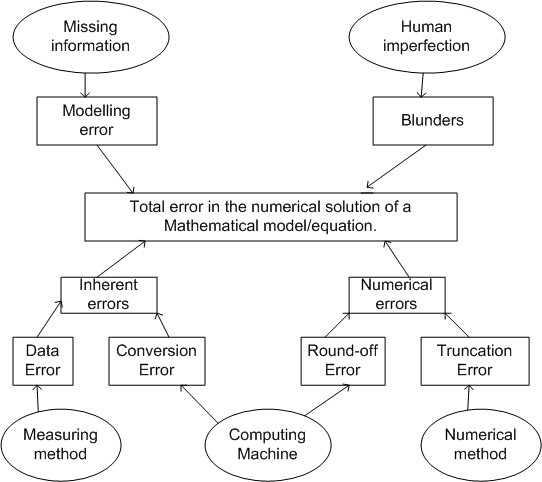![]()
![]()
Next: Computer Representation of numbers and ComputerArithmetic .
Up: Main Previous:Main
![]()
![]()
Next: Computer Representation of numbers and ComputerArithmetic .
Up: Main Previous:Main
Approximations and errors are integral part of numerical methods. Prior to using the numerical methods it is essential to know how errors arise, how they grow during the numerical computations and how they affect the accuracy of a solution.Errors can come in a variety of forms and sizes. To get a quick feel let us look at the following taxonomy of errors:

Further discussion will be focussed on errors due to computing machine and those due to numerical method. Firstly the notion of significant digits will be introduced.
Significant Digits
Usually , the numerical solution to a given problem is sought to a desired level of accuracy and precision wherein the error is below a set tolerance level.The idea of significant numbers is essential to understand the concept of accuracy and precision in the solution and also to designate the reliability of a numerical value.
The Significant Digits of a number are those that can be used
with confidence. Suppose we seek a numerical solution to an
accuracy of ![]() and obtain as solution
and obtain as solution ![]() .
Here the solution is reliable only up to the first three decimal
places i.e
.
Here the solution is reliable only up to the first three decimal
places i.e ![]() or the solution has five
significant digits
or the solution has five
significant digits
![]() .
Some numbers like
.
Some numbers like ![]() ,
,![]() ,
, ![]() etc. have infinite
number of significant digits. For example consider
etc. have infinite
number of significant digits. For example consider ![]() ,
,
![]() =
=
![]()
Such numbers can never be represented exactly on a computer which operates with fixed number of significant digits due to hardware limitations.The omission of certain digits from such numbers results in what is called round-off-error. Some thumb rules on the significant digits , within the desired level of accuracy are :
(a) All non-zero digits are significant ,
(b)All zeros occurring between non-zero digits are significant,
(c)Trailing zeros following a decimal point are significant.
(e.g ![]() ,
, ![]() ,
, ![]() have three significant digits),
have three significant digits),
(d) Zeros between the decimal point and preceding a non-zero digit
are not significant.
For example
![]() ,
,
![]() ,
,![]() , have four significant digits.
, have four significant digits.
(e) Trailing zeros in large numbers without the decimal point are not
significant. For instance ![]() may be written in scientific notation
as
may be written in scientific notation
as
![]() and contains only two significant digits.
and contains only two significant digits.
The concept of accuracy and precision are closely related to
significant digits as follows:
Accuracy refers to the number of significant digits in a value.
For example the number ![]() is accurate to five significant
digits:
Precision refers to the number of decimal positions i.e the order
of magnitude of the last digit in a value. The number
is accurate to five significant
digits:
Precision refers to the number of decimal positions i.e the order
of magnitude of the last digit in a value. The number ![]() has a
precision of
has a
precision of ![]() or
or ![]() .
.
Next: Computer Representation of numbers and ComputerArithmetic Up:Main Previous:Main